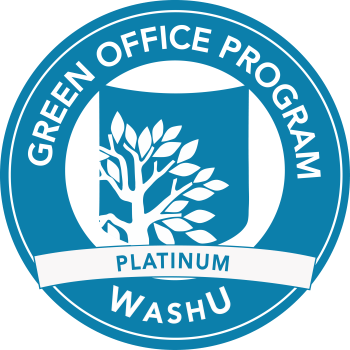
We’ve defined several keywords relating to environmentally friendly, sustainable practices. Learn more about sustainable practices on campus by visiting Washington University’s Office of Sustainability website.
We are pleased to announce that our Purchasing Services office has achieved Platinum certification for the Sustainability Green Office Program as of March 2023.
Biodegradable
Materials that can decompose, usually by bacteria or sunlight, into basic components. Most organic materials (paper, grass clippings, food scraps), under the right conditions, are biodegradable. Reduce/Reuse/Recycle
Sustainability
Social and environmental practices protect and enhance the human and natural resources needed by future generations to enjoy a quality of life equal to or greater than our own. Sustainability Practices
Eco-friendly
Not harmful to the environment.
Environmentally-friendly
Also eco-friendly, nature-friendly, and green, are synonyms used to refer to goods and services considered to inflict minimal or no harm to the environment. [1] To make consumers aware, environmentally-friendly goods and services often are marked with eco-labels. But because there is no single international standard for this concept, the International Organization for Standardization considers such labels too vague to be meaningful. [2] Wiki Definition
Recycled content
Also known as recovered material content, is the percentage of material a product is made from that has been recovered from consumers in the municipal solid waste stream (postconsumer content) plus any industrial materials salvaged for reuse (pre-consumer content). sustainability.wustl.edu
Recyclable
Material that still has useful physical or chemical properties after serving its original purpose can be reused or remanufactured to make new products. Plastic, paper, glass, steel, aluminum cans, and used oil are examples of recyclable materials. sustainability.wustl.edu
Postconsumer content
Percentage of materials recovered by consumers (from the municipal solid waste stream). For example, a newspaper might be made from 30 percent recovered newsprint.
Postconsumer materials
Materials recovered through recycling programs (i.e., materials recovered from the municipal solid waste stream, not from internal industrial processes). These materials are often used to make new products. Newspapers that are recycled by consumers, for example, are post-consumer materials used to make newsprint.
Preconsumer content
Percentage of materials salvaged for reuse from the waste stream of a manufacturing process (rather than from consumers) subsequently used to manufacture a product.
Precycling
The practice of reducing waste by attempting to avoid bringing into the home or business items that will generate waste.
It includes such practices as buying consumables in bulk to reduce packaging, buying consumables in recyclable packaging over non-recyclable packages, avoiding junk mail and using electronic media for reading materials, especially throw-away items such as magazines or newspapers.
As recycling requires large amounts of energy to “meltdown” and then re-manufacture items, it also sends large amounts of pollution into the air. While it may cut down on the amount of trash that is going into landfills, it is not a sustainable answer to the problem of waste. The original three-pronged push for trash management is “Reduce, Reuse, Recycle.” Precycling then is an emphasis on “reducing and reusing”, while harnessing the momentum and popularity of the term “recycle.”
One way to participate in precycling is to carry a “precycling kit” with you when you are out. Include a Tupperware or non-disposable container, silverware set, a cloth napkin or handkerchief, and a thermos or water bottle within a cloth bag that can double as a grocery/shopping bag.
Precycling, then, includes any such attempts to reduce the production of waste. Wiki Definition